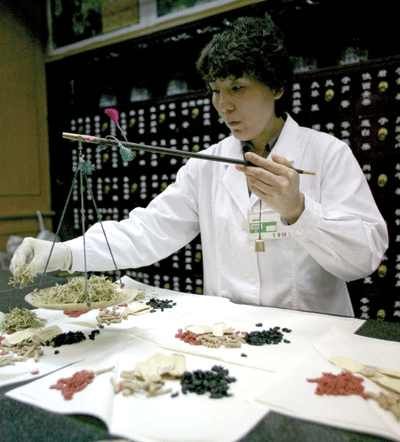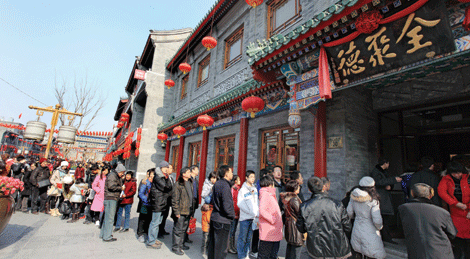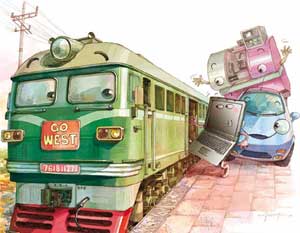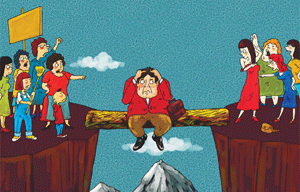Living legends
Updated: 2011-10-17 09:49
By Raymond Zhou and Jin Huiyu (China Daily)
|
|||||||||
|
 |
|
A pharmacist makes up a traditional Chinese medicine prescription at Tongrentang's Qianmen branch in Beijing. [Du Lianyi / China Daily] |
|
 |
|
Customers line up outside Quanjude's Qianmen store before its opening to business. [Da Wei / For China Daily] |
Some brands turn vintage, while others simply become old, putting on ever-thicker layers of rust. The best retain their old glory yet reinvent themselves in the mold of modern entities, Raymond Zhou and Jin Huiyu report.
Old soldiers never die. Likewise, old brands do not quietly fade away. They are either re-invigorated or create a tragic or even heroic last scene.
Longfu used to be one of the few shopping centers in Beijing and attracted endless streams of customers. A fire destroyed the building in 1993. After it was rebuilt - with much expansion - few of those customers returned. In the next decade, management tried as many as 10 new strategies, such as a wholesale market for audio and video products, just when piracy was toppling the whole recorded entertainment industry.
Now this prime downtown location remains eerily empty.
One bus stop away, New Dong'an Market, another of the old big four, has morphed into a shining modern mall, devoid of the "old Beijing" hustle and bustle but lined with squeaky clean boutiques belonging to global brands.
A survey by the Commerce Ministry a few years ago found that of the 16,000 old brands in the country, as many as 70 percent were struggling and only 10 percent prospered. The remaining 20 percent were holding steady.
In recent years, many of the vintage names have been coming back - not as the household names they used to be but as retro brands that appeal to souvenir shoppers and tourists.
In the renovated Qianmen area just south of Tian'anmen Square, you can find many of the city's old retailers. But with skyrocketing rent and demolished old communities, they are now patronized by camera-toting gawkers and curiosity-seekers.
Quanjude is synonymous with Peking roast duck. But nowadays, you do not have to trek down to Qianmen to satisfy your taste buds. There are many outlets throughout the capital city. Or you don't even have to come to Beijing, as there are franchises in other cities, too.
Quanjude is considered a major success in turning around an old brand. It acquired other food businesses as it expanded, all the while retaining its flagship roast duck restaurant. It had its share of upheavals when attempting to walk a fine line between tradition and innovation. Not everyone nodded in agreement when it replaced its old-style stoves with electronic ones.
Now, you can buy a shrink-wrapped roasted duck in a supermarket, so that folks back home can have a sampling of the famed Peking cuisine - more or less authentic but without the bells and whistles of a fine-dining experience - and buy shares from this publicly listed company if you have confidence in its future.
Historical turbulences
Some of China's old brands date back 100 years or more. Rongbaozhai, a maker and retailer of Chinese calligraphy and paintings, as well as the stationery used for them, traces back to 1672. Many of these businesses suffered a branding setback when they were nationalized in the 1950s. For example, Rongbaozhai later became a department within a State-run publishing house.
The old brands were at once beneficiaries and victims of state monopoly. They were known for their good quality and a lack of competitive spirit. During a time of scarcity, they did not need to worry about marketing and management.
At its height, Wangmazi could sell 400,000 pairs of scissors a month. By the new millennium, its debt was twice as high as its assets. The 350-year-old business had to declare bankruptcy. (The brand is still extant, though.)
Most of China's historical brands had their origins in family workshops, where the back room served as the factory floor and the front of the house was reserved for retail. The owner - for example, Wangmazi, or, literally, "Wang of pockmarked face" - equaled the business name, which again equaled the product brand.
This kind of tightly knit operation depended on word of mouth for customer loyalty. Its woes started in the 1990s, when market competition went into overdrive. As if overnight, hundreds of manufacturers of knives and scissors sprang up, mostly in Guangdong province. They offered more varieties of products and better craftsmanship. All the while, Wangmazi depended on one technique of steel encased in iron, which it had invented some time earlier and was an expensive process to begin with.
Later it chose to outsource its manufacturing, but its main manufacturer grew into a rival with more dexterity and richer product offerings. In exasperation, Wangmazi had frequent management shuffles, but failed to reach for a rescue.
"The stiff State-ownership system deprived it of its ability to adapt," says Yang Ruilong, a professor of economics at China Renmin University. "The leaders of Wangmazi, appointed by the government, were accountable only to those government officers who supervised them. They resorted to shortcuts to brush up their scorecards. Each one put lots of money into ill-conceived but flashy projects and left them unfinished. All the while, the brand was rapidly losing value."
Yang does not agree that a conventional product like scissors, which relies on old craft, does not have a chance for survival in an age of global competition. The key, he insists, is innovation. Yang cites the parallel of the Swiss army knife, which has a shorter history but much bigger name on the international stage.
"Innovation is the inexorable driving force for gaining a competitive edge, and that includes traditional craft," he says. "If you cannot compete on the accounts of price, style or functionality, you'll be squeezed out of the market. You cannot simply rest on the laurels of being old."
Rebirth
Tongrentang was a small lab when it was founded in 1699 and now it is the largest TCM (traditional Chinese medicine) drug-maker with billions of yuan in assets. It was given a shot in the arm when a television drama series depicting its history turned into a runaway hit.
Tongrentang prides itself on quality. Its motto is: "Complicated the process may be, we should not save labor; and pricey the material may be, we should not cut corners."
In its expansion into a pharmaceutical giant, Tongrentang sought out partners. It worked with Hong Kong-based Hutchinson Wampoa as a springboard for entering the international market. Its Japanese collaborators helped it change its popular Niuhuang Qingxin pill from an ugly black ball into something more palatable. One of its subsidiaries collaborated with a German company to develop a product that reduces wrinkles around the eye.
However, according to Ding Yongling, general manager of its international operation, Tongrentang is very particular about controlling a majority stake in joint ventures.
"All retailers are fully owned by us," she says.
Tongrentang has the goal of serving all ethnic Chinese across the world. It opened an outlet in London in 1994, but Ding admits that its in-store pharmacist gave prescriptions that puzzled rather than elucidated in a society not quite receptive of TCM.
This kind of drugstore is not even allowed in the United States. Tongrentang had to scale back and focus on the Asia market, where acceptance of TCM was traditionally high. It acquired a TCM hospital and invested in an overseas production base. Now its Asia market, accounts for 90 percent of its overseas sales.
From starting local to going global, Tongrentang has come a long way. While its products remain quintessentially Chinese, its strategy and reach are spreading out. "Traditional Chinese brands must brace for the challenge of presenting themselves on the global platform," Peking University professor Zhang Yiwu says.
"When something is vanishing, a new platform may save it from extinction and give it a new lease on life."











